| Plant Answers > Onions in Containers |
|
|
Onions in Containers
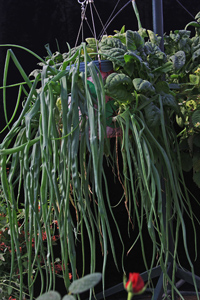
1. Hanging Basket with onions and spinach
|
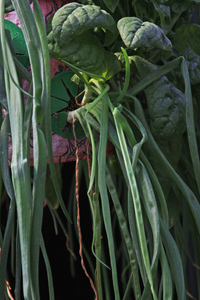
2. Close-up of onions -- two per portal
|
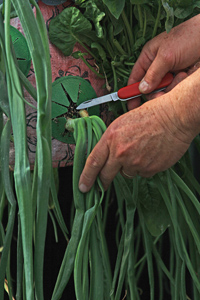
3. One of these onions have to be removed so the other can enlarge to t...
|
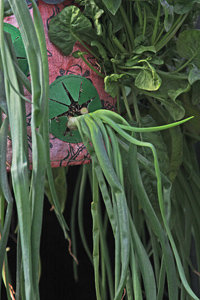
4. The smaller of the onion plants is removed
|
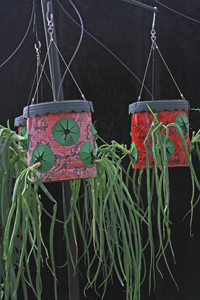
5. The thinned onion container on the left
|
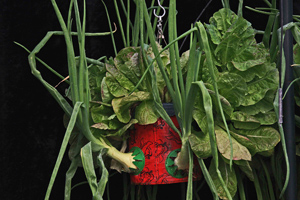
6. Am I doing OK growing onions in a hanging basket!!
|
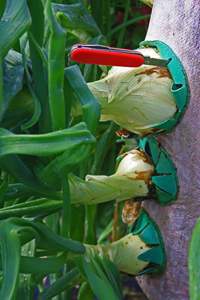
7. ...so a bit of pressure relief is needed to allow the bulb to fully ...
|
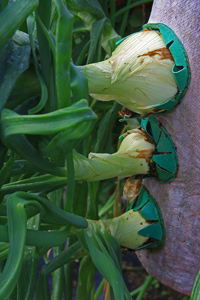
8. Even planting closer spacings seem to produce a reasonable size onio...
|
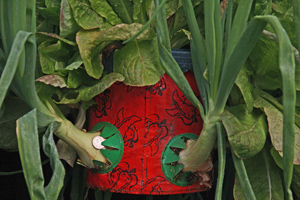
9. Close-up of bulb size
|
-to-one-plant-is-VERY-NEC_Small.jpg)
10. Thinning from 4 plants (left with quarter) to one plant is VERY NEC...
|
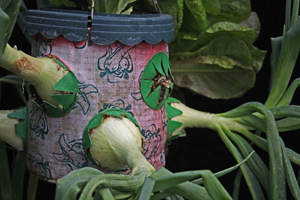
11. Some of the onions are enlarging within the portal
|
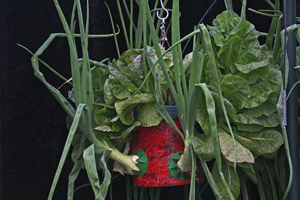
12. I can't get them to size!! note quarter on bulb
|
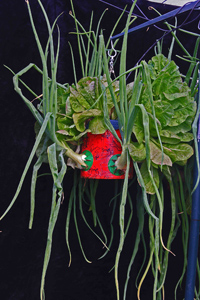
13. Distant image of onion hanging container
|
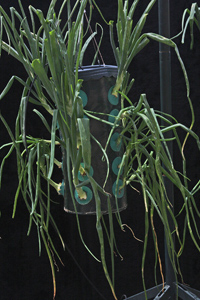
|
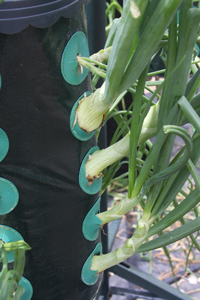
|
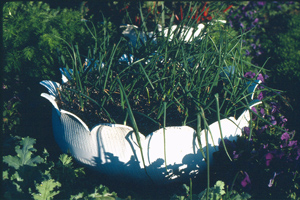
|
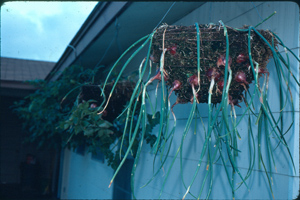
|
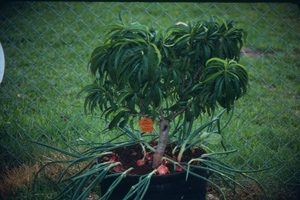
|
How to Grow Onions Successfully – Even in Containers
Have you ever heard the expression: “It is easy to do something if you know how to do it and have the right ingredients”?! Sounds obvious but is so true when dealing with growing onions. Let’s look at the “ingredients” needed for successful onion growing in containers.
When growing onions in containers there are several key factors to consider.
CONTAINER CULTURE
Regardless of the container chosen, adequate drainage is a key to success. A soilless mix which drains rapidly should be used. Ideally, when you pour water around the base of a container-grown plant, water should soon be coming out of the bottom of the container. This not only indicates proper drainage but also enables leaching of fertilizer salts which, if accumulated in heavy, immediate-release concentrations, can damage a plant's roots. Soilless mixes should be soilless-- absolutely no soil! Regardless of how wonderful you think your soil is, when soil is put in a container it loses many of its beneficial qualities. Soil in a container compacts which causes poor drainage and insufficient aeration. Microorganisms such as nematodes and pathogenic fungi may also contaminate the root system if non-pasteurized soil is used. Many suitable types of soilless mixes are commercially available. A soilless mix should be disease and weed-free, retain adequate moisture after watering yet is well-drained and lightweight.
Once you have formulated or purchased a well-drained soilless mix in which to grow the plant, be sure that the container being used has adequate drainage capabilities. If a water-tight container is being used, drainage holes will have to be drilled. A 3- to 5-gallon container should have at least four drainage holes. When considering drainage holes, the olde saying, "The more, the merrier" definitely applies. Also, don't worry about lining the bottom of the container with course gravel or charcoal to expedite drainage. Recent research indicates that such a gradient in materials actually impedes drainage. If a loose soilless mix is used, water drainage through drain holes will not be a problem.
The taller the container, the more difficult it is to obtain even water distribution. Some people utilize whiskey barrels as containers in which to plant. The half-barrels are the easiest to grow in since plants in the bottom section of full-size barrels either don't get enough water or drown from too much water from the top. To insure an even distribution of water throughout the container as well as reduce the amount of soilless mix needed, construct a center core of a rapid draining material. I have had success using a cylinder of concrete reinforcing wire filled with coarse bark. Soilless mix is added around the cylinder from the bottom of the barrel as transplants are placed through drilled holes in the side. Watering is always done in the center core so that plants at the top as well as the bottom have equal access to moisture.
FERTILIZING ONIONS
Onion plants require adequate to extremely high levels of slow-release fertility for vigorous, continuous growth and high yields. Soilless mixes are lacking in sufficient nutrient elements for optimum plant growth. Fertility can be provided in two ways. The most common technique is to periodically water with a fertilizer solution. Commercially prepared, water-soluble formulations are available in local nurseries. Follow label directions when mixing solutions. Never sprinkle granular fertilizer in plant containers; plant damage from salty, immediate-release fertilizer can occur.
Successful production of vegetable crops such as onions depends on rapid, continuous growth and plant vigor so extremely high levels of fertility must be maintained if quality production is expected. This is especially true for onions because, as Bruce Frasier of Dixondale Onion Farms writes:
“The size of the onion bulb is dependent upon the number and size of the green leaves or tops at the time of bulbing. For each leaf, there will be a ring of onion. The larger the leaf, the larger the ring will be when the carbohydrates from the leaves are transferred to the rings of the bulb.”
Since onions are high-maintenance-fertility plants which mature from transplants over a 5 to 6 month period, I recommend the use of copious amounts of slow-release fertilizer pellets mixed into the soilless medium at planting time and/or applied around established plants. This is in addition to the use of water-soluble fertilizer several times weekly. Use the longer release (several months) formulations of the slow-release fertilizer pellets such as Osmocote Plus. Follow, or greatly exceed, label instructions for application or mixing of this slow-release fertilizer, i.e., the label recommends three tablespoons in a two gallon pot --- four times that amount can be used when growing onions. Research indicates that constant feeding (using water-soluble fertilizer) plus the addition of slow-release fertilizer produces a more vigorous plant. It seems that slow-release formulations insure that optimum nutrient elements are always available during periods of potential deficiency when soilless mixes have dried after being watered with the standard nutrient solution. Slow-release fertilizer is also a good, cheap insurance against memory loss-- we might forget to fertilize often enough! It is difficult to fertilize onions with too much Osmocote Plus slow-release fertilizer pellets.
WATERING
Plants have a mobile advantage but the disadvantage of a limited, confined root system. Because culturing plants in containers severely limits their root spread, frequent watering and fertilization are essential. As emphasized earlier, the well-drained soilless mixes--necessary for good aeration--need frequent watering. Check the moisture level of the mix with your finger before watering, i.e., water the mix, not the plant. If you feel moisture with your finger DO NOT WATER; more plants are killed by overwatering than by being too dry. Remember, container size and soilless mix used will have a lot to do with the watering regime followed.
The same principles of success which govern growing in soil apply to growing in containers. If the plant's requirement is a full-sun (8-10 hours daily) condition, an onion plant will not perform at the optimum if grown in the shade--regardless of the care provided. Placement or location of container grown plants is also very important. Even if a plant requires a full-sun condition, afternoon shading of the intense western sun may be beneficial. Also remember the wind. Wind can be devastating. I have found that a northeastern exposure, if available, is the best because of the protection it allows from prevailing strong southern winds and hot evening sun. Protection should be provided from wind gusts.
ONION VARIETY SELECTION
If you don't plant the onion varieties best suited for your area, you are doomed before you begin. The size of the onion bulb is dependent upon the number and size of the green leaves or tops at the time of bulbing. For each leaf, there will be a ring of onion. The larger the leaf, the larger the ring will be when the carbohydrates from the leaves are transferred to the rings of the bulb. The triggering of this transfer or bulbing is dependent upon daylength and temperature and not the size or age of the plants. When selecting your onion varieties, remember that the further north you are, the more hours of daylight you have during the summer. See the map of the U.S. daylength recommendations at: http://www.dixondalefarms.com/category/onion_plants
and on the left side of that page choose varieties from the daylength appropriate to your location listed as: Short-Day Varieties, Intermediate-Day Varieties, Long-Day Varieties, and Specialty Onions. See the video about selecting the best variety for your area at: http://www.dixondalefarms.com/
For true-to-name, a healthy onion transplant, the most reliable source in the U.S. is Dixondale Farms in Carrizo Springs, Texas.
Transplants can be mail-ordered from:
Order Online at: www.dixondalefarms.com
Order by Phone: 1-877-367-1015
Nov. – May: M-F 8:15 a.m. - 5 p.m. CT
Jan. – May: M-F 8:15 a.m. - 5 p.m., Sat. 9 a.m. - 1 p.m. CT
Fax 24 Hours a Day: 1-888-876-9640 or
P.O. Box 129, Department WP17
Carrizo Springs, Texas 78834-6129
The majority of onion transplants sold by retail nurseries are purchased from Dixondale Farms.
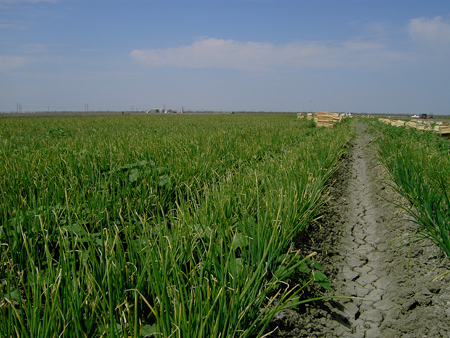
Onion Transplants with shipping boxes at Dixondale
|
|
-out-standing-in-their_Small.jpg)
Two men (Bruce Frasier on left and Jerry Parsons) out standing in their ...
|
PLANTING THE CONTAINER
After selecting the best variety, you must carefully avoid over planting. Balance and number of plants are especially critical in a hanging basket or a container which is to be moved regularly. When actually planting onion transplants, you should make sure the base of the transplant with roots is buried in the prepared potting mix. In the garden it is recommended that the transplants be planted three-fourths inch deep (about knuckle deep) and three to four inches apart. The transplants can be planted deeper in the loose potting mix of a container; make sure the base of the transplant with roots is buried in the prepared potting mix. The onion will form its bulb at the surface of the mix when conditions are right.
Other common sense cultural practices must be exercised with transplants if success is expected. The timing of plantings can make the difference between success and failure. Plant onion transplants 4 to 6 weeks before the last estimated spring freeze. If you want the onions to grow to maturity, space them 4 inches apart. If you prefer to harvest some earlier as green onions, space them 2 inches apart and pull every other onion during the growing season, leaving the rest to grow to maturity.
Container plants are completely dependent on the grower for correct amounts of water and nutrients. A plant in the soil can be neglected for several weeks and Mother Nature's water and nutrients will probably carry the plant through. The plant growing in a container is a different story--neglect the plant for even a day when it is too dry and you can kiss it goodbye. It will die or production will be limited! But because of this life- or-death bondage between grower and plant, and because of this daily interaction, the container often becomes the most precious, loved plant of all. All of the work and worry culminates as you harvest. When you do, you know, without a doubt, that you grew this--it would not exist without your constant care and determination. The largest onions I have ever grown were produced in a hanging basket using the techniques described – see the attached images.
|
|
|
|
| Copyright © 2024 PLANTanswers.com - All Rights Reserved. PLANTanswers and PLANTanswers.com are trademarks of Jerry Parsons. |
|



